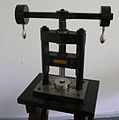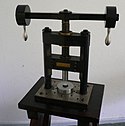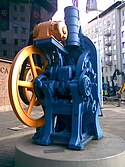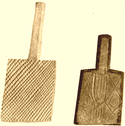Prægning


Ved prægning frembringes aftryk med prægestempler i form af fordybninger eller ophøjede figurer i et stof.
Til prægning kan anvendes håndværktøj eller en kraftig presse − ved forgyldning en forgylderpresse til 'presseforgyldning' − og prægningen foregår så mellem graverede, hærdede og gult anløbne stålstempler. Skal præget være dybt, som til medaljer, gentages operationen én eller flere gange, idet blanketten[1],[2] om fornødent udglødes mellem operationerne.
Prægning foretages navnlig med mønter og medaljer; dog anvendes den også ved fremstilling af gafler, skeer og lignende genstande samt småting som knapper og urkassebunde.
Inden for bogbinderiet anvendes også forskellige slags prægestempler i form af panel- og rullestempler og filéter. På bogbind kan man præge et mønster eller en tekst ved anvendelse af prægeblok eller prægestempler. Præget kan være forgyldt (presseforgyldning[3]), farvelagt eller uden farve, 'blindt', blindtryk.
1832 tog englænderne en forgylderpresse i brug til maskinel prægning af bogbind. Det gjorde det muligt at fremstille billige, maskinudsmykkede forlagsbind − 'komponerede bind'[4] − i konkurrence med de sædvanlige håndindbundne og udsmykkede privatbind.
Galleri


- Forskelligt prægeværktøj
- (c) Foto: Jonn Leffmann, CC BY 3.0Blindprægning med en prægetang kan blandt andet anvendes som signatur på fotografier eller grafiske arbejder
- En manuel prægepresse med udskiftelige ruller
- Mærkater, etiketter, labels
- "Wikipedia" som label
- Dymo labelmaskine fra o. 1967
- Stempler til prægning af bogstaver
- Læder, bogbind
- Prægning på læder
- Supralibros præget på et bogbind
- (c) D. Dornheim, CC BY-SA 2.0 deBlindprægning og håndforgyldning på et bogbind af kalvelæder
- Ruller til prægning af bogbind
- Nærbillede af rulle til prægning af bogbind
- Stempel med løse typer til prægning af rygtitler på bogbind
- Guldprægning fra 1800-tallet
- Papir
- Amerikansk frimærke fra 1861
- Et postkort, ca. 1900-24. Carnegie Library, Houston, Texas
- Et kort af de britiske øer, 1877
- Møntprægemaskiner
- Møntpresse fra Royal Mint, stik fra 1818
- En håndspindelpresse til mønter og medaljer
- Møntpresse fra 1936, udstillet på plads i Polen
Kilde
- "Prægning", bind 19, side 655 i Salmonsens Konversationsleksikon (2. udgave, 1925) af generalmajor F. Wagner og cand.polyt. D.H. Bagger
Noter
- ^ "Blanket" hos Ordnet.dk : pkt. 2)
- ^ Om møntfremstilling hos DanskMoent.dk
- ^ "Presseforgyldning" hos Ordnet.dk
- ^ "Vore ældste komponerede bind - bog- og erhvervshistoriske undersøgelser" (htm-version) Arkiveret 2. april 2015 hos Wayback Machine - (pdf-version (Webside ikke længere tilgængelig)) af bibliotekar, litteraturhistoriker Richard Jakob Paulli (1890-1975) i Fund og Forskning, vol. 7, 1960
Eksterne henvisninger
 Wikimedia Commons har flere filer relaterede til Prægning – Læderprægning – Papirprægning – Blindprægning – Labelmaskiner – Møntpresser
Wikimedia Commons har flere filer relaterede til Prægning – Læderprægning – Papirprægning – Blindprægning – Labelmaskiner – Møntpresser- "Præg" og "Prægestok" hos Ordnet.dk − "Prægning" hos Informationsordbogen.dk
- "Finishing", om den dekorative færdiggørelse af bogbind i The Art of Bookbinding, kapitel 23 (Wikisource)
| Denne artikel stammer hovedsagelig fra Salmonsens Konversationsleksikon 2. udgave (1915–1930). Du kan hjælpe Wikipedia ved at ajourføre sproget og indholdet af denne artikel. Hvis den oprindelige kildetekst er blevet erstattet af anden tekst – eller redigeret således at den er på nutidssprog og tillige wikificeret – fjern da venligst skabelonen og erstat den med et dybt link til Salmonsens Konversationsleksikon 2. udgave (1915–1930) som kilde, og indsæt [[Kategori:Salmonsens]] i stedet for Salmonsens-skabelonen. |
Medier brugt på denne side
Forfatter/Opretter: Edinburgh City of Print, Licens: CC BY 2.0
27 Brass letter stamps in cardboard box. Wooden handled tools with brass heads showing individual characters.
Accession Number: hh.4736.11.88
These brass letter stamps were used by book finishers. The letter stamps were heated up on a gas ring and used to apply the gold leaf onto the leather cover of the book.
Finishing tools primarily could be divided into two categories: rolls and stamps. Rolls consisted of wheels with continuous designs engraved on the circumference, used to create long lines. Fillets?which made plain, straight lines?were the most common rolls. A binder would own several line fillets of different gauges, as well as fillets containing anywhere from one to four parallel lines. Whether working in leather or cloth, binders finally tooled the design and title into the material by making impressions with heated finishing tools. After making a blind impression, the binder sometimes pressed gold leaf into the indentation with the same tools.
These brass stamps are on display at the People's Story Museum, the Canongate, Edinburgh.
Edinburgh City of Print is a joint project between City of Edinburgh Museums and the Scottish Archive of Print and Publishing History Records (SAPPHIRE). The project aims to catalogue and make accessible the wealth of printing collections held by City of Edinburgh Museums. For more information about the project please visit www.edinburghcityofprint.orgForfatter/Opretter: Ditlev Petersen, Licens: CC BY-SA 3.0
Stempel med løse typer til prægning af rygtitler på bogbind.
Indicium of 1861 U.S. letter sheet - George Washington depicted in pink on blue paper
Numis-spindel, fotografiert auf einer Münzausstellung der Münze Berlin 2005.
Old presse used in production of coins. Made in 1936. Shown on the square in front of the Polish Mint building in Warsaw.
Den første engelske forgylderpresse fra 1832 The Imperial Arming Press - Træsnit i J.A. Arnett: Bibliopegia, 1835.
Embossed Postcard, Carnegie Library, Houston, TX (postcard, circa 1900-1924)
Leatherwork done by and photographed by Johan Potgieter, 2005
Paddles traditionally used by the Cherokee people to imprint designs on pottery.
Forfatter/Opretter: Conny, Licens: CC BY-SA 3.0
Prägung eines Buches zur Wesenitz
(c) Foto: Jonn Leffmann, CC BY 3.0
En vitprägel för prägling av fotografiska bilder eller grafikblad.
Forfatter/Opretter: Edinburgh City of Print, Licens: CC BY 2.0
Wooden handled bookfinishing tool. Head of tool is a brass wheel with type letters on edges. These letters were wheeled across the cover of a book.
Accession Number: hh.4726.2.88
Finishing tools primarily could be divided into two categories: rolls and stamps. Rolls consisted of wheels with continuous designs engraved on the circumference, used to create long lines. Fillets?which made plain, straight lines?were the most common rolls. A binder would own several line fillets of different gauges, as well as fillets containing anywhere from one to four parallel lines. Whether working in leather or cloth, binders finally tooled the design and title into the material by making impressions with heated finishing tools. After making a blind impression, the binder sometimes pressed gold leaf into the indentation with the same tools.
This item is on display at the People's Story Museum, the Canongate, Edinburgh.
Edinburgh City of Print is a joint project between City of Edinburgh Museums and the Scottish Archive of Print and Publishing History Records (SAPPHIRE). The project aims to catalogue and make accessible the wealth of printing collections held by City of Edinburgh Museums. For more information about the project please visit www.edinburghcityofprint.orgForfatter/Opretter: Edinburgh City of Print, Licens: CC BY 2.0
Wooden handled bookfinishing tool. Head of tool is a brass wheel with type letters on edges. These letters were wheeled across the cover of a book.
Accession Number: hh.4726.2.88
Finishing tools primarily could be divided into two categories: rolls and stamps. Rolls consisted of wheels with continuous designs engraved on the circumference, used to create long lines. Fillets?which made plain, straight lines?were the most common rolls. A binder would own several line fillets of different gauges, as well as fillets containing anywhere from one to four parallel lines. Whether working in leather or cloth, binders finally tooled the design and title into the material by making impressions with heated finishing tools. After making a blind impression, the binder sometimes pressed gold leaf into the indentation with the same tools.
This item is on display at the People's Story Museum, the Canongate, Edinburgh.
Edinburgh City of Print is a joint project between City of Edinburgh Museums and the Scottish Archive of Print and Publishing History Records (SAPPHIRE). The project aims to catalogue and make accessible the wealth of printing collections held by City of Edinburgh Museums. For more information about the project please visit www.edinburghcityofprint.org(c) D. Dornheim, CC BY-SA 2.0 de
Blindprägung und Handvergoldung nebeneinander auf dem Buchdeckel eines Kalblederbandes. Das Foto des Einbandes ist auf der Seite http://de.wikipedia.org/wiki/Buchbinden#Einband.
Borter påtrykt med såkaldte "filéter" til udsmykning af bogbind - beskrevet side 446 :
"... Forgyldningsredskaberne er Metalstempler, der er udskaarne med de Figurer, som ønskes i Guldet. De glatte, krusede eller forskellig formede Linier, der ofte bruges som »Baand« tværs over Bogryggen, paatrykkes med de saakaldte »Filéter«, der har Form, som Tgn. 607 viser, og paa hvis rundede Bane ophøjet er udgravet forskelige
Borter, som Tgn. 609 viser en Række Prøvetyk af. ..."Forfatter/Opretter: Wolfgang Meinhart, Hamburg, Licens: CC BY-SA 3.0
Steel punch für Bookbindery
Forfatter/Opretter: Junkyardsparkle, Licens: CC0
This DYMO Label-it label maker from the late 1960s produces a more compact lettering than more recent embossers.
Einband, 19. Jahrhundert Reineke Fuchs
Einband (Detail) der Ausgabe des Versepos von Johann Wolfgang von Goethe








































